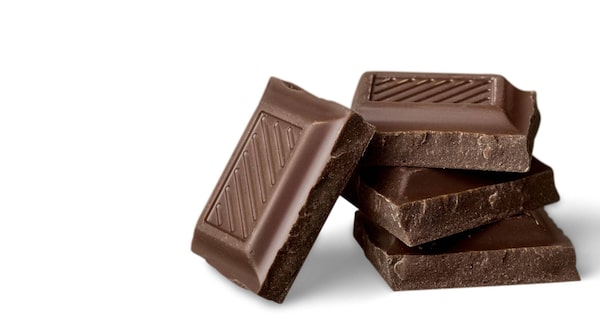
Chocolate is sensual, mysterious and addictive. It's also a perfect gift for lovers and the best choice for a sexy Valentine's Day dessert. When baking, it is important to use the best, which would be the same chocolate you love to eat. Why settle for less?
Today, chocolate is as fancy as wine. You can choose the country of origin, the estates you like best, the percentage of chocolate liquor. But that's for the truly obsessed. Here is a simple chocolate primer for the rest of us.
Chocolate is made from cocoa beans that have been roasted and processed. The resulting mixture is ground and heated into a thick paste called chocolate liquor, which contains roughly equal amounts of cocoa solids (or cocoa mass) and creamy cocoa butter, the "fat" that gives the luxurious mouth feel. This mixture is the basis of unsweetened chocolate. When additional cocoa butter, sugar or milk is added, the chocolate liquor turns into bittersweet or milk chocolate. I find unsweetened chocolate too bitter, but it is sometimes used in Mexican sauces to add a richness and a deeper colour.
Most chocolate has the percentage of cocoa mass listed on the package. The higher the percentage, the darker and more bitter the chocolate. It is not a perfect rule, however. The best way to discover the chocolate you love is to try several different brands. I prefer a 64 per cent to 70 per cent ratio – bittersweet chocolate – for the best baking and eating results. The remaining ingredients are sugar, lecithin and vanilla. Cacao Barry is an excellent brand (available at specialty stores and on Amazon), as is Callebaut, which is often sold in bulk. President's Choice makes a good organic 70 per cent chocolate.
Milk chocolate, which is primarily for eating, contains milk solids and should not be used in baking unless the recipe specifies. White chocolate, a mixture of sugar, vanilla, cocoa butter and milk solids, is technically not chocolate because it does not contain chocolate liquor.
Here are a few tips for working with chocolate
Melt chopped chocolate in a heavy pot on the lowest heat. Double boilers can be problematic as even the smallest drop of water can cause the chocolate to seize or stiffen. Once this happens, there is no cure, although beating in a little vegetable shortening will allow the chocolate to be mixed with other ingredients.
Cut chocolate with a serrated knife; the edges grip the chocolate and make it easier to cut. Shave chocolate with a vegetable peeler.
Store well-wrapped chocolate in a cool place, not in the refrigerator. Moisture causes "bloom," a white surface on the chocolate: It doesn't change the taste, but it looks unattractive.
Need some advice about kitchen life and entertaining? Send your questions to lwaverman@globeandmail.com.
Visit tgam.ca/newsletters to sign up for the Globe Style e-newsletter, your weekly digital guide to the players and trends influencing fashion, design and entertaining, plus shopping tips and inspiration for living well. And follow Globe Style on Instagram @globestyle.
Chef Matt DeMille has a recipe and technique to pull off a sous-vide steak, without the need for an intense immersion circulator machine or vacuum pack.